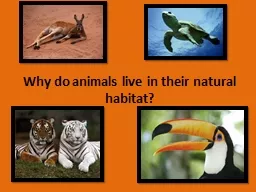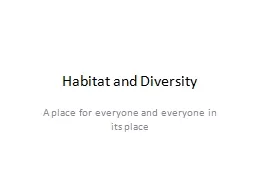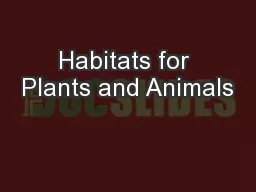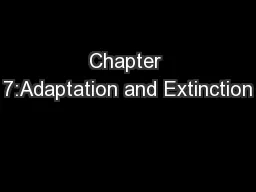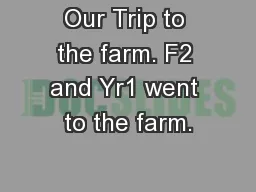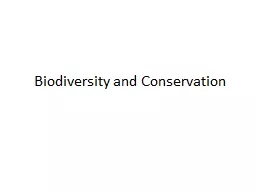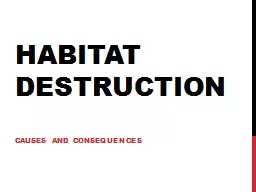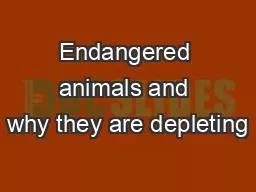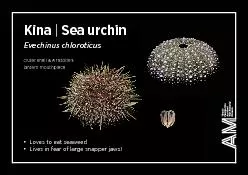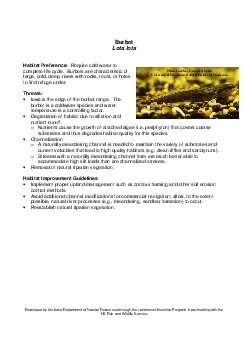PPT-Why do animals live in their natural habitat?
Author : min-jolicoeur | Published Date : 2016-04-23
Why do animals live in their natural habitats Animals live in their habitat because it is the best environment for that particular species to grow and thrive An
Presentation Embed Code
Download Presentation
Download Presentation The PPT/PDF document "Why do animals live in their natural hab..." is the property of its rightful owner. Permission is granted to download and print the materials on this website for personal, non-commercial use only, and to display it on your personal computer provided you do not modify the materials and that you retain all copyright notices contained in the materials. By downloading content from our website, you accept the terms of this agreement.
Why do animals live in their natural habitat?: Transcript
Why do animals live in their natural habitats Animals live in their habitat because it is the best environment for that particular species to grow and thrive An animals habitat must contain a range of different elements in order for survival These elements . Commonly known as the Tasmanian Tiger, the . Thylacine. was the largest known carnivorous marsupial of modern times. Virtually wiped out in the wild due to constant hunting (they were thought to be a threat to sheep and other small farm animals) and the encroachment of humans on their already limited habitat the . 1: . “Land… cannot be treated as an ordinary asset, controlled by individuals and subject to the pressures and inefficiencies of the market. Private land ownership is also a principle instrument of accumulation and concentration of wealth, therefore contributes to social injustice.”. A place for everyone . a. nd everyone in its place. Diversity. Means difference. There are lots of different kinds of living things. We group them into big groups by what they have in common.. The biggest group is kingdom (Animal). By : . Alghaliah. . Abdullaziz. Al . hajri. Grade 2/C. Camels. are the most famous animals that live in the desert.. Camel. is called the Ship of the desert because it can live in the difficult conditions like :. by Mrs. Neetz. What is an environment?. Plants and animals live together in many different environments all around the world.. An . environment. . is all the living and nonliving things in a place. . Mrs. Walker. 4. th. Grade. Adaptations For Survival. Main Idea: To survive, plants and animals must be adapted to their environment. Their adaptations help organisms obtain food, hide from other animals, and generally survive the conditions of their environment.. For our topic on animals, our F2’s to . Brooksby. Farm to look at all of the different animals and to see the new baby lambs that have been born. We even got to stroke one!. In foundation we work from a document called . What is biodiversity?. Bio = life. Diversity = differences among organisms. Biodiversity. = the variety of living organisms found in an area. Where can you find biodiversity?. Biodiversity varies around the world:. Habitat Destruction. Every living thing . requires . somewhere to live, find food and reproduce. .. This . is known as its . habitat. . In order for a species to be viable its habitat must have sufficient territory, necessary food and water and a range of necessary physical features. These features can include tree cover, rocky hills or deep pools, as well as the organisms . By lizzie rogers. Chapter 1 : Animal cards. felines. Animal card 1 : Amur Leopard . Animal class : feline . Reason for endangerment : Habitat destruction, degradation and poaching . Food diet : . roe deer, red deer, musk deer, sika deer, wild boar, hares, badgers . Sea urchinEvechinus chloroticus Outer shell & Aristotle’s lantern mouthpiece Sea urchinEvechinus chloroticusKina populations are increasing, this means they are going to eat lots of seaweed th Burbot Lota lotaHabitat Preference Require cold water to complete life cycle Burbots are characteristic of large cold deep rivers with rocks roots or holes to find refuge under Threats Iowa is the The Video Call Center is a production service & technology company, provides state of the art tools and workflows for today\'s creators. Get an advanced live, recorded and remote production solutions workflow and live broadcast software for the sports, news and entertainment industry. Contact us today! Are you looking reliable broadcast remote production service provider? Get Remote Guests for Live Broadcast and Media Industry. The VCC offers a variety of video remote options, permitting live programming to be created from anywhere an IP connection can be established. Contact us for Video Remote IP Production today!
Download Document
Here is the link to download the presentation.
"Why do animals live in their natural habitat?"The content belongs to its owner. You may download and print it for personal use, without modification, and keep all copyright notices. By downloading, you agree to these terms.
Related Documents

